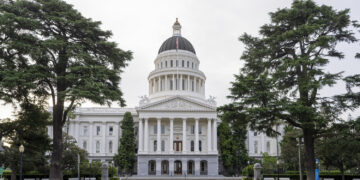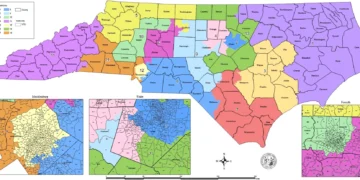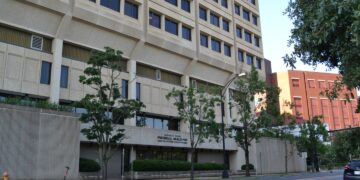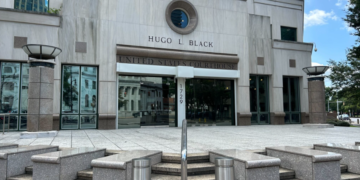May 18, 2025 Story by: Editor
Lawmakers in the Louisiana House have introduced a bill to overhaul the way judges are elected in the 19th Judicial District Court—East Baton Rouge Parish’s trial court—reducing the number of election sections and adding an at‑large seat, a move proponents say modernizes the system but critics warn could dilute minority voting strength.
More than 30 years ago, judicial voting districts were set up in East Baton Rouge Parish to help settle a lawsuit over the lack of Black judges on the bench in Louisiana. Now, a bill moving through the Legislature could, for the first time, redraw those district lines.
State lawmakers are considering a plan to redistrict the 19th Judicial District Court’s election sections, which serve as geographic boundaries for voting for judges.
A new map could significantly alter the judiciary when Baton Rouge Parish residents vote for more than a dozen state district court judges next year. The 19th JDC covers East Baton Rouge Parish. Within that area, there are currently three election sections, also referred to as voting subdistricts.
Each subdistrict gets to choose five of the court’s 15 judges, an arrangement that resulted from a legal settlement in the 1990s that aimed to protect Black voting rights.
But some lawmakers argue the map of judicial voting districts drawn decades ago is woefully out of date and doesn’t reflect the current racial makeup of the parish.
What the Bill Would Do
House Bill 124, sponsored by Rep. Barbara Freiberg (R), would amend state law to change the 19th Judicial District Court’s election map in three key respects:
- Cut election sections from three to two. Currently, the parish is divided into three “election sections,” each choosing five judges. HB 124 would collapse those into two larger sections, each electing seven judges.
- Add a single at‑large seat. One judge would be elected by all parish voters, rather than from a specific section.
- Reassign divisions to sections. Under the proposal, Divisions A, D, J, K, L, M, and O would vote in Section 1; Divisions C, E, F, G, H, I, and N in Section 2; and Division B at large.
The change is estimated to cost an additional $267,076 from the state’s General Fund in the upcoming fiscal year.
According to 2020 U.S. Census data, there are about 457,000 people living in East Baton Rouge Parish, and of that group, 42% are White and 45% Black. Census estimates of the parish from 2023 show a smaller population that is 41% White and 43% Black.
Currently, there are about 289,000 registered voters in the parish, 49% of whom are White and 45% of whom are Black, according to Secretary of State data provided by the East Baton Rouge Parish Registrar of Voters.
The current number and racial makeup of registered voters in the voting subdistricts of the 19th JDC includes:
- Section 1: Roughly 55,000 registered voters, 13% White and 83% Black
- Section 2: Roughly 100,00 registered voters, 43% White and 52% Black
- Section 3: Roughly 134,000 registered voters, 68% White and 24% Black
An analysis of the proposal prepared by nonpartisan legislative staff using voter registration from December 2024 would create two election districts:
- Section 1: Roughly 125,000 voters, 22% White and 73% Black
- Section 2: Roughly 143,000 voters, 73% White and 20% Black
Under the proposed plan, 51% of the parish’s 457,000 residents would live in Section 1 and 49% of the parish’s population would live in Section 2.
Voting rights
The current three voting subdistricts were the result of a 1986 lawsuit brought over the way judges were elected in Louisiana by a group of Black attorneys, including now-retired 19th JDC judge Janice Clark.
They argued that the state’s previous districtwide system of electing judges violated the Voting Rights Act by diluting Black voter strength.
The yearslong legal battle resulted in the creation of judicial election subdistricts meant to give African Americans a better shot at election to Louisiana’s judgeships.
East Baton Rouge Parish was one of several district courts where new judicial voting subdistricts were instituted.
Lawmakers’ Rationale
Rep. Freiberg argues the reform is overdue. “This legislation will align our judicial elections with current population patterns, streamline administrative processes, and ensure more consistent representation across the parish,” she said during committee debate.
Supporters note that East Baton Rouge’s demographics and precinct lines have shifted significantly since the three‑section format was adopted in 1994, and that a two‑section plus at‑large model will better reflect those changes.
Concerns from Civil‑Rights Advocates
Opponents caution that reducing the number of sections and introducing an at‑large seat risks diluting the voting power of Black neighborhoods—particularly in north and west Baton Rouge, where a majority of residents are African American. Civil‑rights groups point out that, by consolidating sections, minority communities might be outvoted more easily in judicial contests.
Committee Action & Next Steps
HB 124 was introduced on March 25, 2025, and, after amendments, was recommitted to the House Appropriations Committee on May 15. If it passes the legislature and is signed by the governor, the new system would take effect for the next regularly scheduled judicial election.
The Broader Context
Louisiana is one of only a handful of states that elects trial‑court judges by sub‑district; most others use at‑large or statewide contests. Redrawing judicial‑election lines is rare—prior comprehensive changes came in 1994—but debates over fairness and representation have resurfaced as communities advocate for mapping that mirrors both population and racial equity concerns.
With the bill pending appropriations review, Baton Rouge’s bar associations, civic organizations, and voter‑rights groups are gearing up for public hearings. The outcome will influence not only how judges reach the bench, but also how justice is dispensed—and perceived—in Louisiana’s capital city.
Sources: NOLA / BillTrack50 / LegiScan

















